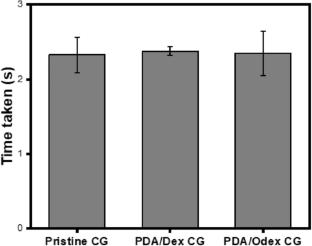Oxidized dextran-modified cotton gauze for application as a fouling-resistant wound dressing
Abstract
Cotton gauze (CG) is the most commonly used primary wound dressing to protect wounds from the external environment. However, it is highly susceptible to fouling due to the adhesion of bacteria present on the wound surface. Bacterial colonization of the dressing is detrimental as it aids in wound infection and delays wound healing. To mitigate this issue, the objective of this study was to transform the inert CG into a fouling-resistant wound dressing that can actively resist bacterial adhesion and also prevent biofilm formation on the surface of cotton. In this work, a facile method of modifying commercial CG using oxidized dextran (Odex) was developed. Odex was derived from dextran via periodate oxidation reaction and then coated over the CG using mussel-inspired chemistry. The resultant Odex-modified CG demonstrated a substantial reduction in bacterial adhesion after 4 h of incubation in bacterial suspension. The modified gauze suppressed biofilm formation, achieving ~83% reduction in viable bacterial count as compared to unmodified CG after 48 h of incubation in the bacterial suspension. In addition, the modified CG also showed good breathability, wettability and moisture retention properties. The results suggest a promising approach of transforming inert CG into a potential fouling-resistant wound dressing for the management of wound infections.


 求助内容:
求助内容: 应助结果提醒方式:
应助结果提醒方式:


